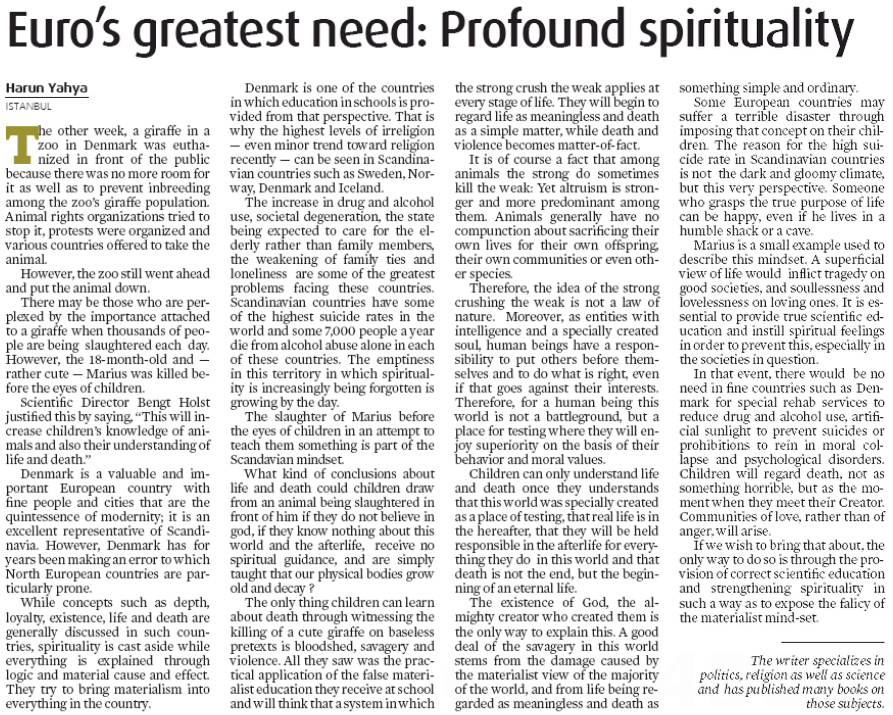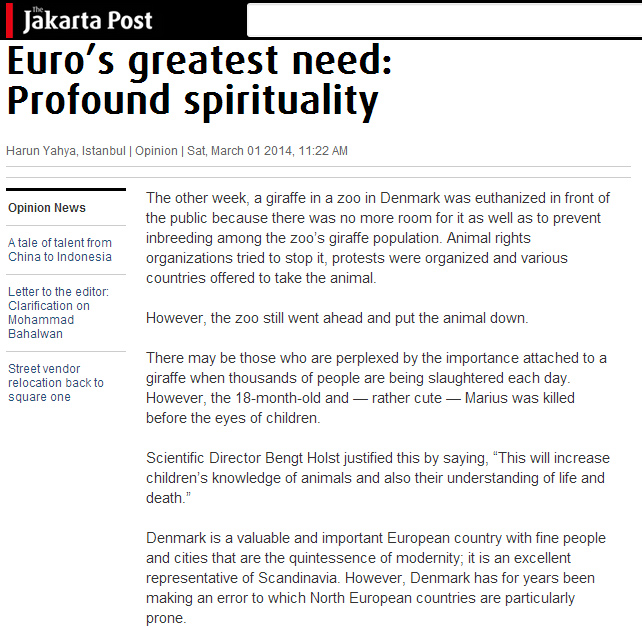


The other week, a giraffe in a zoo in Denmark was euthanized in front of the public because there was no more room for it as well as to prevent inbreeding among the zoo’s giraffe population. Animal rights organizations tried to stop it, protests were organized and various countries offered to take the animal.
However, the zoo still went ahead and put the animal down.
There may be those who are perplexed by the importance attached to a giraffe when thousands of people are being slaughtered each day. However, the 18-month-old and — rather cute — Marius was killed before the eyes of children.
Scientific Director Bengt Holst justified this by saying, “This will increase children’s knowledge of animals and also their understanding of life and death.”
Denmark is a valuable and important European country with fine people and cities that are the quintessence of modernity; it is an excellent representative of Scandinavia. However, Denmark has for years been making an error to which North European countries are particularly prone.
While concepts such as depth, loyalty, existence, life and death are generally discussed in such countries, spirituality is cast aside while everything is explained through logic and material cause and effect. They try to bring materialism into everything in the country.
Denmark is one of the countries in which education in schools is provided from that perspective. That is why the highest levels of irreligion — even minor trend toward religion recently — can be seen in Scandinavian countries such as Sweden, Norway, Denmark and Iceland.
The increase in drug and alcohol use, societal degeneration, the state being expected to care for the elderly rather than family members, the weakening of family ties and loneliness are some of the greatest problems facing these countries. Scandinavian countries have some of the highest suicide rates in the world and some 7,000 people a year die from alcohol abuse alone in each of these countries. The emptiness in this territory in which spirituality is increasingly being forgotten is growing by the day.
The slaughter of Marius before the eyes of children in an attempt to teach them something is part of the Scandavian mindset.
What kind of conclusions about life and death could children draw from an animal being slaughtered in front of him if they do not believe in god, if they know nothing about this world and the afterlife, receive no spiritual guidance, and are simply taught that our physical bodies grow old and decay ?
The only thing children can learn about death through witnessing the killing of a cute giraffe on baseless pretexts is bloodshed, savagery and violence. All they saw was the practical application of the false materialist education they receive at school and will think that a system in which the strong crush the weak applies at every stage of life. They will begin to regard life as meaningless and death as a simple matter, while death and violence becomes matter-of-fact.
It is of course a fact that among animals the strong do sometimes kill the weak: Yet altruism is stronger and more predominant among them. Animals generally have no compunction about sacrificing their own lives for their own offspring, their own communities or even other species.
Therefore, the idea of the strong crushing the weak is not a law of nature. Moreover, as entities with intelligence and a specially created soul, human beings have a responsibility to put others before themselves and to do what is right, even if that goes against their interests. Therefore, for a human being this world is not a battleground, but a place for testing where they will enjoy superiority on the basis of their behavior and moral values.
Children can only understand life and death once they understands that this world was specially created as a place of testing, that real life is in the hereafter, that they will be held responsible in the afterlife for everything they do in this world and that death is not the end, but the beginning of an eternal life.
The existence of God, the almighty creator who created them is the only way to explain this. A good deal of the savagery in this world stems from the damage caused by the materialist view of the majority of the world, and from life being regarded as meaningless and death as something simple and ordinary.
Some European countries may suffer a terrible disaster through imposing that concept on their children. The reason for the high suicide rate in Scandinavian countries is not the dark and gloomy climate, but this very perspective. Someone who grasps the true purpose of life can be happy, even if he lives in a humble shack or a cave.
Marius is a small example used to describe this mindset. A superficial view of life would inflict tragedy on good societies, and soullessness and lovelessness on loving ones. It is essential to provide true scientific education and instill spiritual feelings in order to prevent this, especially in the societies in question.
In that event, there would be no need in fine countries such as Denmark for special rehab services to reduce drug and alcohol use, artificial sunlight to prevent suicides or prohibitions to rein in moral collapse and psychological disorders. Children will regard death, not as something horrible, but as the moment when they meet their Creator. Communities of love, rather than of anger, will arise.
If we wish to bring that about, the only way to do so is through the provision of correct scientific education and strengthening spirituality in such a way as to expose the falicy of the materialist mind-set.
Adnan Oktar's article on The Jakarta Post:
http://www.thejakartapost.com/news/2014/03/01/euro-s-greatest-need-profound-spirituality.html


